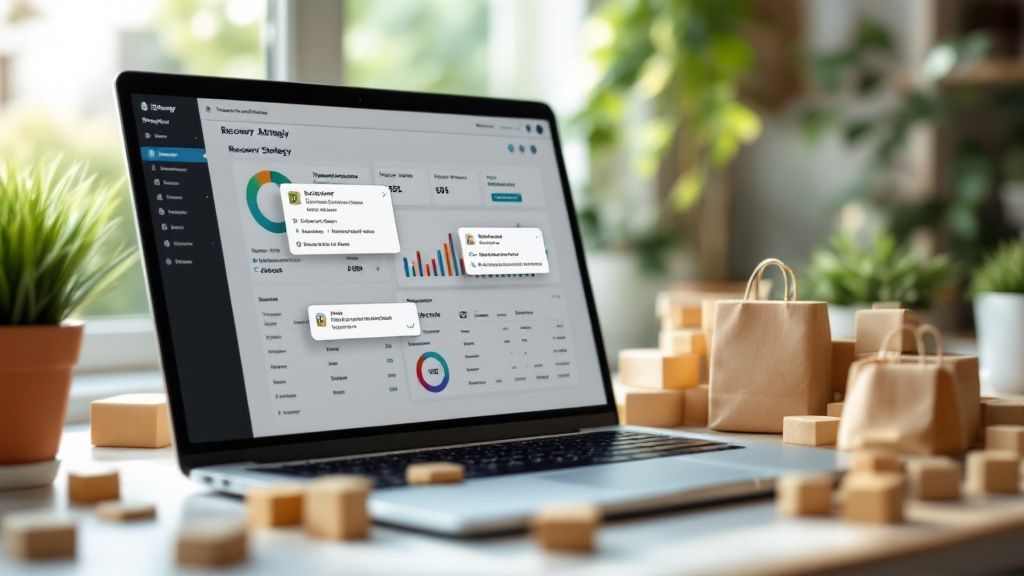What does 4PL – Fourth-Party Logistics / 5PL – Fifth-Party Logistics mean in Shopify?
August 24, 2024

If you’re an e-commerce business owner looking to expand your reach and streamline your operations, you might have come across the terms 4PL and 5PL logistics. These terms refer to different types of logistics providers who can help manage your supply chain and improve your overall customer experience. But what exactly are 4PL and 5PL logistics, and how can you integrate them into your Shopify store for maximum benefit?
Understanding the Basics of Logistics in E-commerce
Before diving into the specifics of 4PL and 5PL logistics, it’s essential to understand the basics of logistics in the context of e-commerce. At its core, logistics in e-commerce involves managing the flow of products, information, and funds between different parties in the supply chain, including manufacturers, suppliers, distributors, retailers, and end customers.
This process is complex and multifaceted, involving multiple touchpoints and potential bottlenecks. For example, the time it takes to source and ship products from a manufacturer can impact the speed and quality of delivery to end customers. Additionally, managing inventory levels, tracking shipments, and handling returns requires a high level of coordination and data management.
One of the key aspects of e-commerce logistics is the importance of speed and efficiency. In traditional logistics, businesses may have more time to plan and execute shipments, but in e-commerce, customers expect fast and reliable delivery. This means that e-commerce businesses must carefully balance the need for speed with the costs of shipping and handling.
The Evolution of Logistics in E-commerce
As e-commerce has grown in popularity and complexity, logistics has evolved to meet the changing needs of businesses and customers. Traditional logistics strategies, such as warehousing and transportation management, have been supplemented by advanced technologies and service providers.
One of the most significant changes has been the rise of third-party logistics (3PL) providers who offer specialized services such as freight forwarding, warehousing, and order fulfillment. These providers can help e-commerce businesses scale their operations and reduce costs by leveraging economies of scale and expertise in specific niches.
Another key development in e-commerce logistics has been the use of automation and artificial intelligence. These technologies can help businesses streamline their logistics processes, reduce errors, and improve the customer experience. For example, automated inventory management systems can help businesses track product levels in real-time and automatically reorder when inventory falls below a certain threshold.
Key Differences Between Traditional and E-commerce Logistics
While traditional logistics and e-commerce logistics share many similarities, there are key differences that make e-commerce logistics more complex. For example, e-commerce logistics must account for the rapid pace of online sales and the need for precise inventory management across multiple channels.
Additionally, e-commerce logistics involves managing multiple shipments to different locations, which can result in higher shipping costs and increased complexity. Finally, e-commerce logistics must prioritize customer experience and satisfaction, which requires careful management of returns and real-time visibility into shipment tracking.
One of the biggest challenges in e-commerce logistics is managing returns. Unlike traditional retail, where customers can physically return products to a store, e-commerce returns often involve shipping products back to a warehouse or fulfillment center. This can be a costly and time-consuming process, and businesses must have clear policies in place to manage returns effectively.
In conclusion, logistics is a critical component of e-commerce, and businesses must carefully manage the flow of products, information, and funds to ensure fast and reliable delivery to customers. By leveraging advanced technologies and working with specialized service providers, e-commerce businesses can streamline their logistics processes and improve the customer experience.
Defining 4PL – Fourth-Party Logistics
With this context in mind, let’s explore 4PL logistics in more detail. A 4PL provider is a logistics specialist who acts as an intermediary between a business and multiple 3PL providers. The goal of a 4PL provider is to manage the end-to-end logistics process, from initial planning and sourcing to final delivery and customer service.
Unlike a 3PL provider who offers specific services, a 4PL provider takes a more strategic approach, focusing on optimizing the entire supply chain and coordinating between multiple parties. A 4PL provider may leverage advanced technologies such as predictive analytics and network optimization to improve efficiency and reduce costs.
The Role of a 4PL Provider
A 4PL provider acts as a central point of contact for an e-commerce business and manages the entire logistics process. This may include:
- Inbound logistics: Planning and sourcing raw materials and components from suppliers
- Warehousing and inventory management: Optimizing storage and fulfillment processes to reduce costs and improve accuracy
- Transportation management: Coordinating shipments across multiple 3PL providers and optimizing routes and delivery times
- Customer service: Handling inquiries and complaints from end customers in real-time
Benefits of Using a 4PL Provider in Shopify
There are several benefits to using a 4PL provider in Shopify:
- Improved visibility: A 4PL provider can provide real-time visibility into your supply chain, allowing you to make more informed decisions and quickly respond to changes.
- Cost savings: By optimizing the entire logistics process, a 4PL provider can reduce costs and improve efficiency, ultimately resulting in a lower total cost of ownership.
- Scalability: A 4PL provider can help you scale your operations rapidly by leveraging their expertise and existing partnerships with multiple 3PL providers.
- Enhanced customer experience: By prioritizing end-to-end customer experience, a 4PL provider can ensure timely and accurate deliveries, reduce errors and delays, and improve overall satisfaction.
How to Choose the Right 4PL Provider for Your Shopify Store
Choosing the right 4PL provider can be a complex process, but there are several key factors to consider:
- Experience: Look for a provider with a track record of success in the e-commerce industry and specific expertise in your niche.
- Cost: Compare costs and services across multiple providers to determine the best value for your business.
- Technology: Ensure that your provider leverages advanced technologies to optimize your supply chain and provide real-time visibility.
- Communication: Look for a provider who prioritizes clear and timely communication and can act as a trusted advisor throughout the logistics process.
Exploring 5PL – Fifth-Party Logistics
While 4PL logistics can help e-commerce businesses optimize their entire supply chain, a newer concept called 5PL logistics takes this idea one step further. A 5PL provider is a logistics specialist who acts as a strategic partner and consultant, focusing on creating value beyond the logistics process.
5PL providers may offer additional services such as data analytics, marketing, and customer experience management to help e-commerce businesses improve their bottom line and brand reputation.
The Role of a 5PL Provider
A 5PL provider acts as a trusted partner and advisor to an e-commerce business, providing strategic guidance and support. This may include:
- Market research and analysis: Helping businesses gain a better understanding of their market and competition
- Brand strategy and positioning: Developing a unique brand identity and messaging to differentiate a business from its competitors
- Customer experience management: Optimizing every touchpoint of the customer journey to increase satisfaction and loyalty
- Data analytics and business intelligence: Leveraging data to gain insights and make informed decisions across the business
- Supplier management: Managing relationships with suppliers and partners to ensure the highest quality products and services
Advantages of Using a 5PL Provider in Shopify
There are several advantages to using a 5PL provider in Shopify:
- Strategic guidance: A 5PL provider can provide valuable strategic guidance to help your business grow and succeed in a competitive marketplace.
- Innovative solutions: With a focus on value creation beyond logistics, a 5PL provider may offer innovative solutions to help your business stand out and make an impact.
- Data-driven insights: By leveraging data analytics and business intelligence, a 5PL provider can help you make more informed decisions and stay ahead of trends.
- Brand positioning: A 5PL provider can help you develop a unique brand identity and messaging that resonates with your target audience.
Selecting the Best 5PL Provider for Your Shopify Store
Choosing a 5PL provider requires careful consideration of several factors:
- Expertise: Look for a provider with experience in your niche and a track record of success in delivering value beyond logistics.
- Culture fit: Ensure that the provider shares your values and philosophies and can work effectively with your team.
- Service offerings: Assess the provider’s service offerings to determine whether they align with your business needs and goals.
Comparing 4PL and 5PL in Shopify
While both 4PL and 5PL providers can offer significant value to e-commerce businesses, there are key differences between the two that make them suitable for different scenarios.
Key Differences Between 4PL and 5PL Providers
The main differences between 4PL and 5PL providers are:
- Scope: 4PL providers focus on optimizing the logistics process, while 5PL providers focus on creating value beyond logistics.
- Expertise: 4PL providers specialize in logistics, while 5PL providers may have expertise in multiple areas, including marketing, data analytics, and customer experience management.
- Relationships: 4PL providers manage relationships with other logistics providers, while 5PL providers may manage relationships with suppliers, customers, and other partners.
Which One is Right for Your Shopify Store?
The choice between a 4PL and 5PL provider ultimately depends on your business needs and goals. If you’re primarily looking to optimize your logistics process and reduce costs, a 4PL provider may be the best fit. Alternatively, if you’re focused on creating value beyond logistics and differentiating your brand, a 5PL provider may be the better choice.
Integrating 4PL and 5PL Solutions into Your Shopify Store
If you’ve decided that a 4PL or 5PL provider is the right fit for your Shopify store, the next step is to integrate their services into your operations. This involves several steps:
Steps to Implement 4PL or 5PL Services
The steps to implement 4PL or 5PL services in your Shopify store are:
- Assess your logistics needs: Determine which areas of your logistics process need improvement and which services you require.
- Research and select a provider: Research multiple providers to compare costs, services, and expertise and select the one that best fits your needs.
- Establish clear communication: Ensure that communication channels are open and that you understand each other’s expectations and roles in the process.
- Integrate technology: Integrate the provider’s technology solutions into your store systems to enable real-time visibility and data sharing.
- Continuously monitor and evaluate: Regularly evaluate the performance of your logistics provider and communication your feedback to drive ongoing improvement.
Monitoring and Evaluating the Performance of Your Logistics Provider
Continuous monitoring and evaluation of your logistics provider is essential to ensure that you’re getting the most value from their services. Key performance indicators (KPIs) that you can track include:
- Order fulfillment accuracy
- Order lead time
- On-time delivery rates
- Inventory accuracy and turnover
- Customer satisfaction and complaints
- Cost savings and efficiency gains
By tracking these metrics and communicating your findings with your logistics provider, you can drive ongoing improvement and ensure that you’re getting the most value from their services.
Conclusion
4PL and 5PL logistics providers offer valuable services that can help e-commerce businesses optimize their supply chain, improve customer experience, and increase profitability. By understanding the key differences between these providers, assessing your business needs, and carefully selecting the right provider for your Shopify store, you can integrate their services to drive ongoing success and growth.
 Checkout Links
Checkout Links



